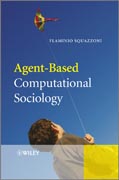
Most of the intriguing social phenomena of our time, such as international terrorism, social inequality, and urban ethnic segregation, are consequences of complex forms of agent interaction that are difficult to observe methodically and experimentally. This book looks at a new research stream that makes use ofadvanced computer simulation modelling techniques to spotlight agent interaction that allows us to explain the emergence of social patterns. It presents a method to pursue analytical sociology investigations that look at relevant social mechanisms in various empirical situations, such as markets, urban cities,and organisations.This book:Provides a comprehensive introduction to epistemological, theoretical and methodological features of agent-based modelling in sociology through various discussions and examples.Presents the pros and cons of using agent-based models in sociology.Explores agent-based models in combining quantitative and qualitative aspects, and micro- and macro levels of analysis.Looks at how to pose an agent-based research question, identifying the model building blocks, and how to validate simulation results.Features examples ofagent-based models that look at crucial sociology issues.Supported by an accompanying website featuring data sets and code for the models included in the book.Agent-Based Computational Sociology is written in a common sociological language and features examples of models that look at all the traditional explanatory challenges of sociology. Researchers and graduate students involved in the field of agent-based modelling and computer simulation in areas such as social sciences, cognitive sciences and computer sciences will benefit from this book. INDICE: Preface ix1 What is agent-based computational sociology all about?11.1 Predecessors and fathers 31.2 The main ideas of agent-based computational sociology 91.2.1 The primacy of models 91.2.2 The generative approach 111.2.3 The micro-macro link 131.2.4 Process and change 151.2.5 The unexcluded middle 161.2.6 Trans-disciplinarity 171.3 What are ABMs? 181.4 A classification of ABM use in social research 20References 262 Cooperation, coordination and social norms 332.1 Direct reciprocity and the persistence of interaction 362.2 Strong reciprocity and social sanctions 422.3 Disproportionate prior exposure 492.4 Partner selection 542.5 Reputation 622.6 The emergence of conventions 69References 783 Social influence 853.1 Segregation dynamics 883.2 Threshold behavior and opinions 973.3 Culture dynamics and diversity 1033.4 Social reflexivity109References 1224 The methodology 1314.1 The method 1344.2 Replication 1404.2.1 The querelle about segregation 1444.2.2 The querelle about trust and mobility 1474.3 Multi-level empirical validation 151References 1595 Conclusions 165References 172Appendix A 175A.1 Research centers 175A.2 Scientific associations 177A.3 Journals 178A.4 Simulation tools 179References 179Appendix B 181B.1 Example I: Partner selection and dynamic networks (Boero, Bravo and Squazzoni 2010) 182B.2 Example II: Reputation (Boero et al. 2010) 211References 234Index 235
- ISBN: 978-0-470-71174-3
- Editorial: John Wiley & Sons
- Encuadernacion: Cartoné
- Páginas: 256
- Fecha Publicación: 06/04/2012
- Nº Volúmenes: 1
- Idioma: Inglés
